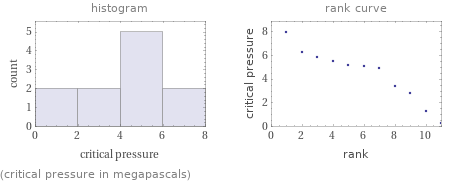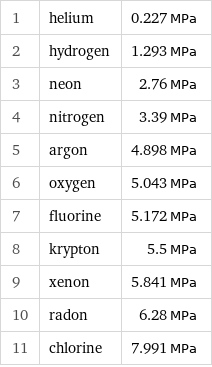Input interpretation

gaseous elements (at STP) | critical pressure
Summary

median | 5.043 MPa highest | 7.991 MPa (chlorine) lowest | 0.227 MPa (helium) distribution |
Units

Distribution plots

(critical pressure in megapascals)
Critical pressure rankings

1 | helium | 0.227 MPa 2 | hydrogen | 1.293 MPa 3 | neon | 2.76 MPa 4 | nitrogen | 3.39 MPa 5 | argon | 4.898 MPa 6 | oxygen | 5.043 MPa 7 | fluorine | 5.172 MPa 8 | krypton | 5.5 MPa 9 | xenon | 5.841 MPa 10 | radon | 6.28 MPa 11 | chlorine | 7.991 MPa
Unit conversions for median critical pressure 5.043 MPa

5.043×10^6 Pa (pascals)

5.043×10^6 N/m^2 (newtons per square meter)

514.2 tf/m^2 (metric tons-force per square meter)

49.77 atm (atmospheres) (unit officially deprecated)

50.43 bars

504.3 dbar (decibars)

0.05043 kbar (kilobars)

514.2 m WC (meters of water column)

0.5142 km WC (kilometers of water column)

731.4 psi (pounds-force per square inch)

105300 lbf/ft^2 (pounds-force per square foot)
Comparisons for median critical pressure 5.043 MPa

≈ 0.5 × pressure exerted by a 45 kg woman wearing stiletto heels ( ≈ 1×10^7 Pa )

≈ 0.6 × atmospheric pressure on the surface of Venus ( ≈ 9 MPa )

≈ (0.3 to 2.5) × typical pressure range in a light water nuclear reactor ( 2 to 17 MPa )
Corresponding quantity

Depth of water d giving gauge pressure p_e from p_e = ρ_(H_2O)gh: | 514 meters | 0.32 miles | 1687 feet | (assuming maximum water density ≈ 1000 kg/m^3)